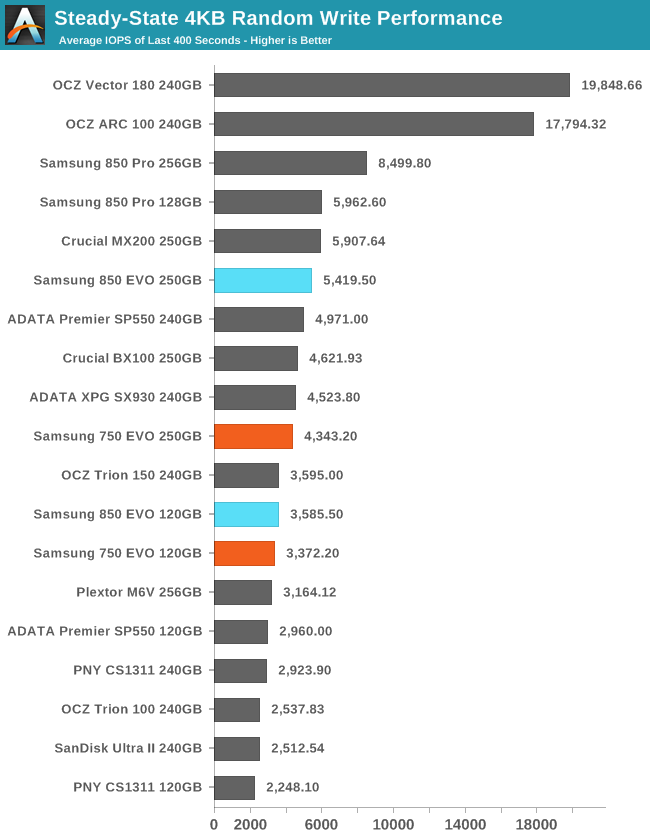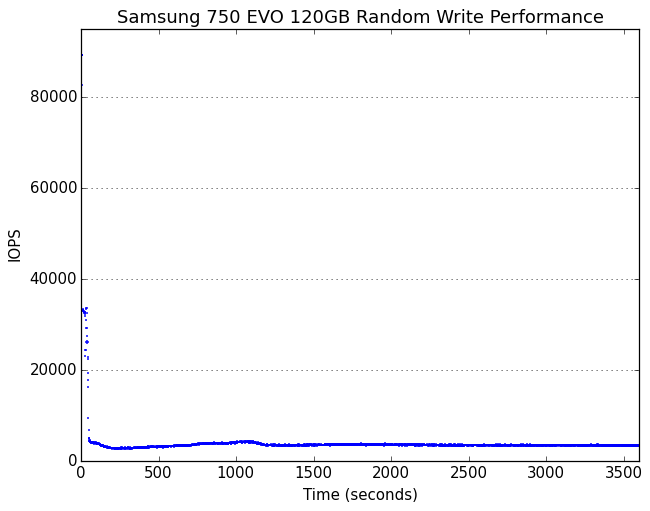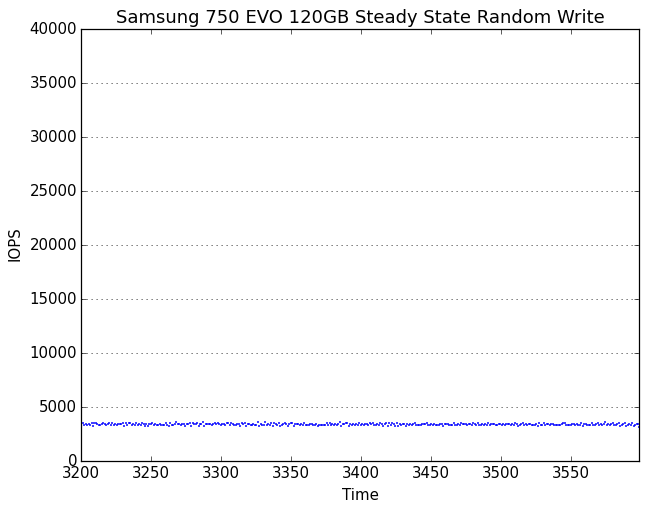The Samsung 750 EVO (120GB & 250GB) SSD Review: A Return To Planar NAND
by Billy Tallis on April 22, 2016 8:00 AM ESTPerformance Consistency
Our performance consistency test explores the extent to which a drive can reliably sustain performance during a long-duration random write test. Specifications for consumer drives typically list peak performance numbers only attainable in ideal conditions. The performance in a worst-case scenario can be drastically different as over the course of a long test drives can run out of spare area, have to start performing garbage collection, and sometimes even reach power or thermal limits.
In addition to an overall decline in performance, a long test can show patterns in how performance varies on shorter timescales. Some drives will exhibit very little variance in performance from second to second, while others will show massive drops in performance during each garbage collection cycle but otherwise maintain good performance, and others show constantly wide variance. If a drive periodically slows to hard drive levels of performance, it may feel slow to use even if its overall average performance is very high.
To maximally stress the drive's controller and force it to perform garbage collection and wear leveling, this test conducts 4kB random writes with a queue depth of 32. The drive is filled before the start of the test, and the test duration is one hour. Any spare area will be exhausted early in the test and by the end of the hour even the largest drives with the most overprovisioning will have reached a steady state. We use the last 400 seconds of the test to score the drive both on steady-state average writes per second and on its performance divided by the standard deviation.

Starting with a look at steady-state performance, the 750 EVO is clearly inferior to the 850 EVO, particularly at 250GB. But it outperforms most of the planar TLC competition and the occasional low-end MLC drive.

The high consistency score is a hallmark of Samsung's top-notch controller architecture. The 750 EVO is in an entirely different league from the planar TLC drives.
 |
|||||||||
| Default | |||||||||
| 25% Over-Provisioning | |||||||||
The 750 EVO's initial burst of high performance is relatively short-lived, but it transitions into a very well-regulated steady state. The gradual performance recovery before a second smaller drop in performance is less pronounced than on the other Samsung drives, but is still present.
With extra overprovisioning, the 750 EVO's steady state shows much looser performance regulation but is still delivering a better worst-case than its competition's best-case.
 |
|||||||||
| Default | |||||||||
| 25% Over-Provisioning | |||||||||
A closer look at the 750 EVO's steady state is pretty boring, with no clear patterns of periodic background maintenance or sporadic outliers.










109 Comments
View All Comments
DanNeely - Friday, April 22, 2016 - link
The cheap SSD will still blow the spinning rust in the other crappy TN 720p laptop out of the water.jabber - Friday, April 22, 2016 - link
Yeah amazing how limited people's imaginations are when it comes to hardware and other peoples usage needs. Unless it's pushing 2GBps it's junk. Tedious people. If every laptop in the world with a cheap 5400rpm HDD in it swapped to one of these 'bottom of the barrel' Samsung SSDs, it would be a revelation. Make my job of support a lot easier and faster.Movieman420 - Friday, April 22, 2016 - link
Keep in mind, launch prices are always a bit high. Sammy could sell em for less at retail...but they're really not after retail with the 750...they wanna move em in bulk minus retail packaging costs. As far as performace, they're just right...for the intended market. As a budget OEM part, the vast majority of end users (80% maybe?) will fall in Anands light bench metric where this drive makes a pretty good showing. Any better would risk cannibalizing EVO sales. Overall, this product and placement was well thought out by Samsung...as usual....and from a performance standpoint a lil over-provisioning goes a long way. I'm assuming it's not compatible with magician's RAPID mode...unless say your a huge oem customer who'd pay a tad extra and make it a performance offering in more expensive lappys with enuff ram.
iwod - Friday, April 22, 2016 - link
What we need to know is final street price, not launch price.Because as it stand i have Zero reason to buy them. It needs at least a 50% price cost.versesuvius - Saturday, April 23, 2016 - link
As long as Samsung is clearing unused chips from its stock, it could just offer these drives for $25 each to make a gesture of good will towards its existing customers and make some new ones too.The_Assimilator - Saturday, April 23, 2016 - link
Good to see you're "revieiwng" this drive. Could you maybe consider reviewing a spellchecker and/or editor in future?zodiacfml - Saturday, April 23, 2016 - link
Cheapest option but purchased separately, $10 difference is not worth it.The perrformance of the 850 is useful for most people savvy enough to replace drtives.
serendip - Saturday, April 23, 2016 - link
$10 may be a big BOM savings for large system builders but it's pocket change for consumers looking to upgrade from a hard drive. This drive probably isn't aimed at you :)I wouldn't trade $10 for half the write longevity and potentially other issues from using planar TLC. The 850 Evo is still the king and the Sandisk Ultra II is also a good deal when it goes on sale.
Peroxyde - Sunday, April 24, 2016 - link
How is the Corsair LE compared to 850 EVO, 750 EVO? In terms of reliability?odedia - Sunday, April 24, 2016 - link
According to Amazon.com, this drive is currently more expensive then the 250gb 850 Evo. Makes zero sense to buy this today. maybe in a year it will be priced accordingly.